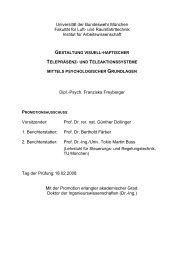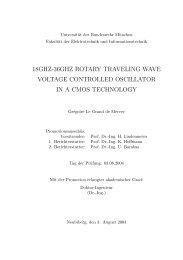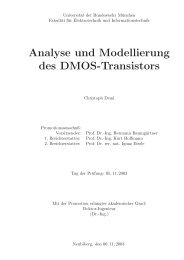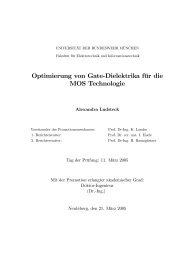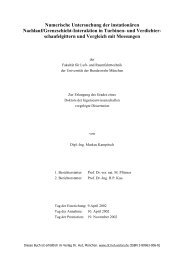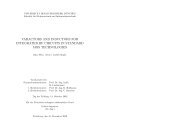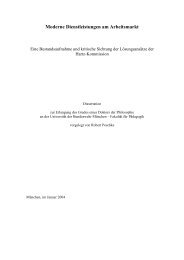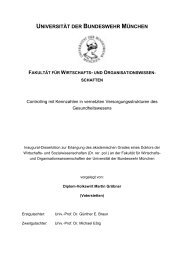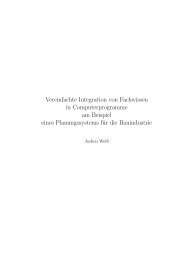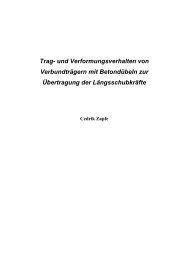Precise Orbit Determination of Global Navigation Satellite System of ...
Precise Orbit Determination of Global Navigation Satellite System of ...
Precise Orbit Determination of Global Navigation Satellite System of ...
Create successful ePaper yourself
Turn your PDF publications into a flip-book with our unique Google optimized e-Paper software.
Chapter 9 S<strong>of</strong>tware and Simulation Results<br />
situation. In this section, the satellite visibility will be considered in the dynamic orbit determination. The<br />
satellite visibility, however, is a big problem for resolving initial ambiguity. The visibility <strong>of</strong> a IGSO satellite<br />
located at λ =-10° with eight tracking stations has been shown in Figure 9-5.<br />
From Figure 9-5 it can be seen that except the tracking stations Kourou (5) and Libreville (6), which are located<br />
near the equator, the observations <strong>of</strong> carrier phase from other tracking stations and IGSO satellites are<br />
discontinuous due to satellite visibility. After re-tracking the satellite at the tracking stations, the new initial<br />
ambiguities must be introduced in the observations. For example, from Figure 9-5, for tracking station 7 and 8,<br />
the first session <strong>of</strong> continuous observation is only about three hours. It is not enough time for this three-hour<br />
observation session to resolve all initial ambiguities due to the high altitude <strong>of</strong> the IGSO satellite (refer to §7.2.1,<br />
Chapter 7). Then observations are interrupted because the satellite is not visible from these two tracking stations.<br />
After a six hour interruption, the satellite will be seen again and re-locked, the new initial ambiguities must be<br />
introduced and solved, which will affect the accuracy <strong>of</strong> satellite orbit determination (see Figure 9-30, Figure 9-<br />
31 and Figure 9-32). But, if the accuracy with centimeter level <strong>of</strong> orbit determination has been achieved before<br />
observation interruption, the satellite visibility will not be a problem, because the satellite orbit can be precisely<br />
predicted by satellite dynamic models. The new initial ambiguities can be computed according to precise satellite<br />
orbit and the coordinates <strong>of</strong> ground tracking stations.<br />
For convenience in simulation, the true initial ambiguities will be set according to Table 9-2. When the satellites<br />
are re-tracked, the same true initial ambiguities will be set as before. This assumption will not affect the actual<br />
accuracy <strong>of</strong> orbit determination. It is only convenient for graphical illustration. In order to save text volume, in<br />
the following figures only the ambiguity solutions from the tracking stations 1 and 5 are given. The observation<br />
from the tracking station 1 was not continuous, whereas tracking station 5 was continuous. The initial<br />
ambiguities solved as float ambiguities are shown as follows respectively.<br />
Ambiguity<br />
Ambiguity<br />
21<br />
20.8<br />
20.6<br />
20.4<br />
20.2<br />
20<br />
19.8<br />
19.6<br />
19.4<br />
19.2<br />
19<br />
101<br />
100.8<br />
100.6<br />
100.4<br />
100.2<br />
100<br />
99.8<br />
99.6<br />
99.4<br />
99.2<br />
99<br />
0 24 48 72 96 120 144 168 192 216 240<br />
Tim e (hour)<br />
Figure 9-30 Float Ambiguity Solution <strong>of</strong> a IGSO <strong>Satellite</strong> at λ =-10° at Tracking Station 1<br />
0 24 48 72 96 120 144 168 192 216 240<br />
Tim e (hour)<br />
Figure 9-31 Float Ambiguity Solution <strong>of</strong> a IGSO <strong>Satellite</strong> at λ =-10° at Tracking Station 5<br />
127



